Pickleball, a superb combination of tennis, badminton, and ping-pong, has surprised the game world. Whether you’re a seasoned player or a curious beginner, understanding the nuances of pickleball paddles can significantly impact your game and sleep quality. In this article, we investigate the advantages of pickleball, the science behind paddle choice, and how this game can add to all the more likely rest.
The Essentials of Pickleball
What is pickleball?
Pickleball is a social and cordial game played by two or four individuals on a court. The standards are basic: use oars to hit a punctured plastic ball over the net, permitting it to bob something like once on each side. The main group to arrive at 11 focuses wins. A game joins readiness, technique, and brotherhood.
Medical Advantages of Pickleball
Physical Activity and Sleep
Research consistently shows that regular physical activity improves sleep quality and duration. Participating in pickleball gives a full-body exercise, working your heart, lungs, and muscles. As you play, your energy balance improves, feelings of anxiety decline, and your body delivers those great chemicals. After an energetic pickleball match, you’re likely going to partake in a more serene night’s rest.
Heart Well-being and Generally Prosperity
Pickleball isn’t just about fun; it’s likewise about wellbeing. Customary play improves cardiovascular wellness, making ordinary undertakings feel more straightforward. Also, the social part of the game adds to mental prosperity. Interfacing with individual players and partaking in the outside air on the court influences your general personal satisfaction.
Picking the Right Pickleball Oar
Power versus Control
- Power: If you’re a middle or high-level player with strong oar control, consider a heavier oar with a fiberglass surface. The additional weight and thickness take into account strong shots.
- Control: Beginners and halfway players benefit from lightweight oars with carbon fibre surfaces. These oars make it more straightforward and to the point.
Turn Potential
Twist can be a distinct advantage. Paddles with dirty, finished surfaces create topspin and reverse pivot, making it harder for adversaries to return the ball.
Center Material Matters
The center material influences power and control. Most oars have a polymer or polypropylene center in a honeycomb chamber. This plan limits vibration and productively circulates energy during play.
Perfect balance
Stirring things up around the town spot (the center of your oar) brings about better accuracy, power, and a wonderful skip. Novice paddles frequently have bigger, perfect balances for more straightforward play.
Top Pickleball Oars
Our broad testing uncovered the accompanying top pickleball paddles:
- Selkirk Amped S2: A fair oar with great control and power.
- Paddletek Small EX-L: lightweight, flexible, and ideal for turn shots.
- JOOLA Carbon Master: Ideal for players looking for a mix of force and accuracy.
Using Innovation in Pickleball: Tips for Apple Watch Clients
Apple Watch and Pickleball Medical Advantages
Apple’s Heart and Development Study features the medical advantages of pickleball. Analysts tracked down patterns in both pickleball and tennis exercise information, stressing the potential well-being benefits of the two exercises. This is the way the Apple Watch can improve your pickleball experience:
Movement Following
Exercise Application: Utilize the inherent exercise application on your Apple Watch to follow your pickleball meetings. Select “Other” as the exercise type, and the watch will screen your pulse, calories consumed, and dynamic minutes.
Pulse Checking: The watch persistently tracks your pulse during play. Focus on your pulse zones, whether you’re in the fat-consuming zone or stretching your boundaries.
Recuperation Bits of knowledge
Resting Pulse: Screen your resting pulse over the long haul. A lower resting pulse shows better cardiovascular wellness and general well-being.
Rest Following: Great rest is vital for execution. Apple Watch screens your rest designs, assisting you with streamlining rest and recuperation.
Method and Structure
Video Recording: Utilize your iPhone to record your pickleball strokes. Dissect your procedure and structure later to recognize regions for development.
Apple Watch Camera Remote: If you’re rehearsing alone, set up your iPhone as a camera and utilize your Apple Watch as a controller. Catch your interactivity from various points.
Social Inspiration
Action Sharing: Contend with companions and individual pickleball devotees. Share your movement information, challenge one another, and remain inspired.
Pickleball People group: Join pickleball bunches via web-based entertainment. Examine techniques, share tips, and interface with players around the world.
Nourishment and Hydration Updates
- Water Admission: Set updates on your watch to remain hydrated. Appropriate hydration is fundamental for maximized execution.
- Sustenance Following: Utilize outsider applications to log your dinners and track macronutrients. Fuel your body sufficiently for extraordinary pickleball matches.




